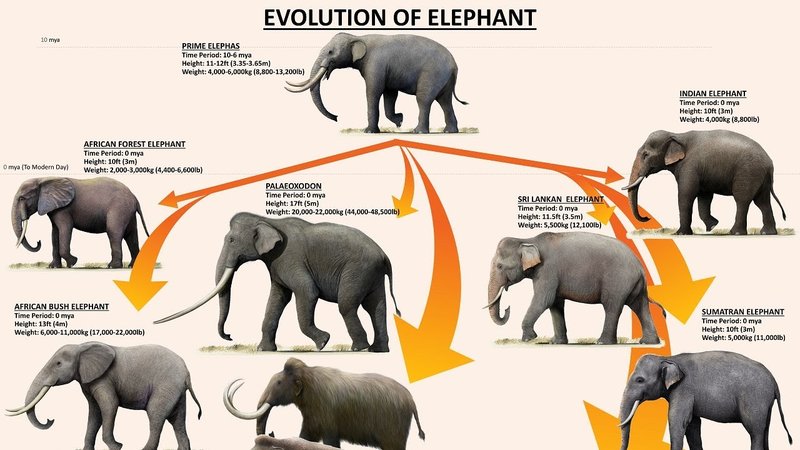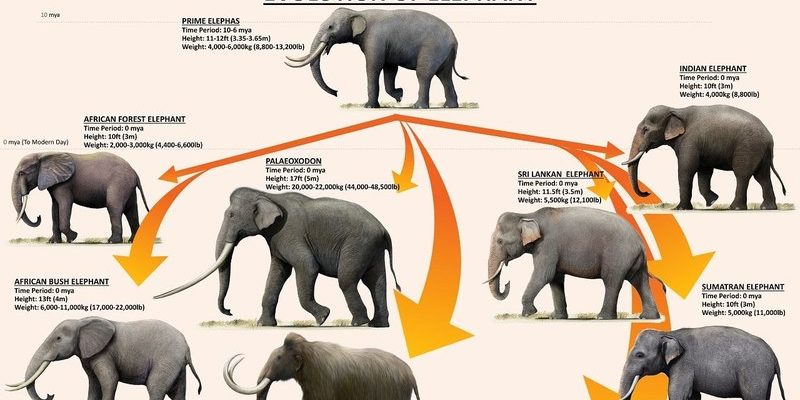
The African Forest Elephant is not just a smaller version of the more well-known African Savanna Elephant. They have distinct traits, behaviors, and—most importantly—an evolutionary history that shapes their survival in the thick jungles they call home. So, grab your favorite coffee, and let’s dive into the fascinating timeline of these remarkable creatures.
What Defines the African Forest Elephant?
The African Forest Elephant, scientifically known as *Loxodonta cyclotis*, is often less recognized compared to its larger cousin, the African Savanna Elephant (*Loxodonta africana*). One of the most striking features of the forest elephant is its smaller size, with males typically weighing between 8,800 to 10,000 pounds, which is quite hefty but not nearly as massive as the savanna counterpart.
The African Forest Elephant also sports a unique shape to its tusks. Instead of being long and straight like those of the savanna elephants, their tusks are shorter and often curved. This adaptation is more suited for maneuvering through dense vegetation. Think of it as having the right tools for the job. If their tusks were straight, they might find it challenging to navigate through the thick, tangled underbrush that makes up their habitat.
Another fascinating aspect is their smaller ears, which help minimize heat loss that could occur in the cooler forest environment. It’s a clever adaptation! In a world where every detail can mean life or death, evolution has finely tuned these elephants to thrive in their specific niche.
The Importance of Genetic Diversity
Genetics play a key role in understanding the evolutionary history of the African Forest Elephant. These elephants are believed to have diverged from their savanna relatives around 2 to 6 million years ago. During this time, changes in climate and the formation of the Congo Basin created isolated environments fostering genetic differences.
This genetic diversity is important for their survival. It allows the population to adapt to varying conditions and challenges, such as diseases and climate change. In essence, it’s like having a family of superheroes, each with unique powers to tackle different problems. If one superhero falls short, another can step in and save the day.
However, genetic diversity is under threat due to habitat loss and poaching. When a population shrinks, genetic diversity can diminish, making it harder for these elephants to adapt to future challenges. This is why conservation efforts are crucial; we need to protect not just the elephants but their genetic legacy too.
Adaptations to Forest Life
Living in dense forests is no walk in the park—literally. The African Forest Elephant has evolved several adaptations that make them well-suited for this environment. For starters, their smaller size allows them to move quietly and efficiently among trees, avoiding unnecessary noise that could alert predators or other animals.
Additionally, these elephants have developed a flexible diet. They feast on leaves, fruits, and even bark, depending on what’s available. This adaptability is crucial for surviving in a habitat where food sources can vary widely with the seasons. It’s a bit like being a chef; you have to know how to whip up a meal with whatever ingredients you have on hand.
Their social structures are also fascinating. Unlike some other elephant species, African Forest Elephants tend to form smaller, more fluid groups. This helps them navigate the tricky maze of the forest and maintain flexibility in their social interactions. Think of it as a close-knit family who can rely on one another but also knows how to break off and take care of individual needs when necessary.
Threats and Conservation Efforts
Sadly, the African Forest Elephant faces numerous threats in today’s world. Poaching for ivory is one of the biggest challenges they encounter. Although their tusks are smaller, they are still targeted, leading to devastating population declines. This is heartbreaking. Each lost elephant not only impacts their family but also the whole ecosystem in which they play a critical role.
Habitat loss is another major issue. As forests are cleared for agriculture and development, these majestic creatures find it increasingly difficult to survive. It’s like losing your home and being forced to live in a crowded, unfamiliar place. Conservationists are working tirelessly to protect their habitats and establish safe corridors for their migration.
Organizations and governments are also promoting anti-poaching laws and creating sanctuaries where these elephants can thrive without threat. But it’s not just about protecting them; it’s also about education. When communities understand the importance of these elephants, they can become active participants in their conservation.
The Future of the African Forest Elephant
So, what does the future hold for the African Forest Elephant? That’s a tricky question. The challenges they currently face are formidable, but hope remains. Advances in conservation technology, like GPS tracking, are helping scientists gather data to protect elephant populations more effectively. This is a bit like using a map and compass in an unfamiliar territory—knowing where to go makes a world of difference.
Public awareness is also growing, with more people recognizing the unique status of the African Forest Elephant and advocating for its protection. Increasing support from local communities and global conservation organizations provides a framework for a more hopeful future.
Ultimately, like all elephants, the African Forest Elephant is a vital part of its ecosystem. By preserving their populations, we ensure not just their survival, but the health of the forests they inhabit and the diverse life forms dependent on them.
In the grand tapestry of life, the African Forest Elephant is an essential thread, rich with history and significance. As they navigate their dense forest homes, they remind us of the delicate balance of nature and the importance of protecting it. Their evolutionary journey has shaped them into the remarkable beings they are today, equipped to thrive in their unique environment.
By understanding their story and the challenges they face, we can all play a part in ensuring a future where these magnificent creatures continue to roam the forests of Africa. The next time you think about elephants, remember the African Forest Elephant, and consider how you can contribute to their conservation. Every action counts, and together, we can help secure a brighter future for these incredible animals.

